PLASMA NUTFAH BABI BALI MUTIARA YANG TERPENDAM
Abstract
Millennium Development Goals has been mandated to always strived to reduce therate of loss of biodiversity as a very valuable genetic resources. Bali swine germplasmwhose condition is increasingly threatened by the inclusion of various types of pigs thathave the ability to produce more meat. Last post five years, Bali’s pig population in theprovince of Bali continued to decline and reached until 30 percent (243 310 head) of allpigs in Bali (817 489 head). Of the pig population in Bali as much as 53 percent in Buleleng.Bali pig role in socio-cultural activities and opportunities to explore the culinary marketrequires no effort to increase productivity in a sustainable pig Bali. Various strategicapproach to the development and preservation of pig Bali described in this paper as aneffort to accelerate the achievement of the millennium development.Downloads
Keywords
Authors who publish with this journal agree to the following terms:
- All articles published by Bumi Lestari Journal of Environment and Environmental Reseach Center Udayana University are made available under an open access license worldwide immediately. This means everyone has free and unlimited access to the full-text of all articles published in Bumi Lestari Journal of Environment, and everyone is free to re-use the published material given proper accreditation/citation of the original publication. Open access publication is supported by authors' institutes or research funding agency by payment of a comparatively article processing charge for accepted articles (See Author Fees). Bumi Lestari Journal of Environment and Environmental Reseach Center Udayana University publish articles under the Creative Commons Attribution License.
- Authors are able to enter into separate, additional contractual arrangements for the non-exclusive distribution of the journal's published version of the work (e.g., post it to an institutional repository or publish it in a book), with an acknowledgement of its initial publication in this journal.
- Authors are permitted and encouraged to post their work online (e.g., in institutional repositories or on their website) prior to and during the submission process, as it can lead to productive exchanges, as well as earlier and greater citation of published work (See The Effect of Open Access).





